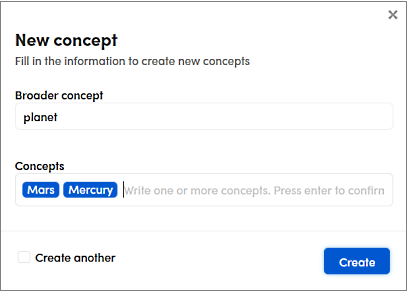Define the tree
The concepts tree
Platform displays thesaurus concepts in the nodes of a tree structure.

The taxonomy corresponds to the narrower/broader relation between concepts: child nodes are narrower concepts while parent nodes are broader concepts.
Note
First-level nodes don't have parent nodes, they are children of the tree root, conventionally represented by the Thesaurus node.
The same concept can appear in several locations of the tree: it can have more than one broader concepts and so be the child of more than one node.
The taxonomy tree is displayed in the Resources panel, in the left portion of the Resources tab of the project dashboard.
Display the tree nodes
To expand and collapse tree nodes to show and hide narrower concepts:
- Select the right arrow
 placed to the left of a concept name to expand it.
placed to the left of a concept name to expand it. - Select the down arrow
 placed to the left of a concept name to collapse it.
placed to the left of a concept name to collapse it.
Or:
- Select the concept then select Expand node
 or Collapse node
or Collapse node  to the right of the concept label.
to the right of the concept label.
Or:
- Hover over the concept and select Expand node
 or Collapse node
or Collapse node  to the right of the concept label.
to the right of the concept label.
To expand and collapse all tree nodes at once:
- Hover over Thesaurus and select Expand node
 or Collapse node
or Collapse node  to the right.
to the right.
Find concepts in the tree
To search for a concept in the taxonomy tree, enter the concept name—at least three characters—in the search box, then press Enter.
To reset the search criteria, select  .
.
Add nodes
Add nodes from the Resources panel
To create a first-level concept under the root of the tree:
- Select Create concept
 .
.
Or:
- Hover over Thesaurus and select Create concept
 .
.
To create narrower concepts for an existing concept:
-
Select the broader concept or hover over it and choose Create concept
 . The New concept dialog appears.
. The New concept dialog appears.
-
If you want to specify a different position for the concept in the tree, change the value of Broader concept.
Note
If you start typing in Broader concept, a drop-down menu showing concepts with matching labels is displayed and you can choose the broader concept from it.
-
Enter one of more words corresponding to the new concept in Concepts and press
Enter. Repeat this step to add more concepts. - Select Create another if you want to re-open the dialog immediately after the concept creation.
- Select Create to end the concepts creation procedure.
Add nodes from the Edit Concept panel
- Select a concept in the tree of the Resources panel.
- Select the Relations tab inside the Edit Concept panel.
-
Select the plus button:
- Under BROADER CONCEPTS if you want to create a parent node.
Or:
- Under NARROWER CONCEPTS if you want to create a child node.
-
Enter the concept label—one or more words—and press
Enter.
Add nodes using suggestions
You can also add suggested concepts as described in Add concepts using suggestions.
Add nodes during annotation
Concepts can also be added while annotating the expected results.
Move nodes
To move a concept node within the tree, drag it to its new position.
Delete nodes
Delete nodes from the Resources panel
- Select the concept, then select Delete concept
 .
. - Select Delete to confirm.
Or:
- Hover over a concept, then select Delete concept
 .
. - Select Delete to confirm.
Or:
- Select the concept of interest.
- Select Delete concept
 on the Edit Concept panel toolbar.
on the Edit Concept panel toolbar. - Select Delete to confirm.
Warning
When you delete a concept, all narrower concepts (children nodes) are deleted too.
Delete nodes from the Edit Concept panel
- Select a concept in the tree of the Resources panel.
- Select the Relations tab of the Edit Concept panel.
- Hover over a concept belonging to BROADER CONCEPTS or to NARROWER CONCEPTS then select Delete
 .
.
Delete multiple concepts
To delete multiple concepts:
- Select the concepts using
CTRL+CLICK. - Select
 .
. - Select Delete to confirm.
Invisible relations
The tree shows the concepts according to the narrower/broader taxonomy, but it is possible to link the concepts to each other also with other relations.